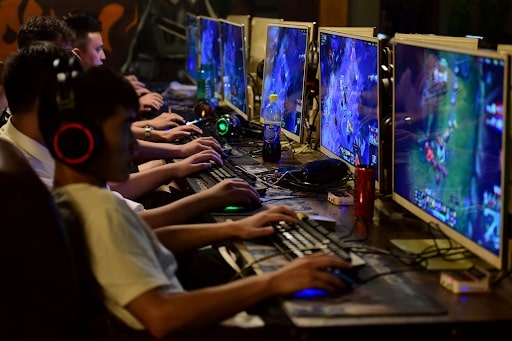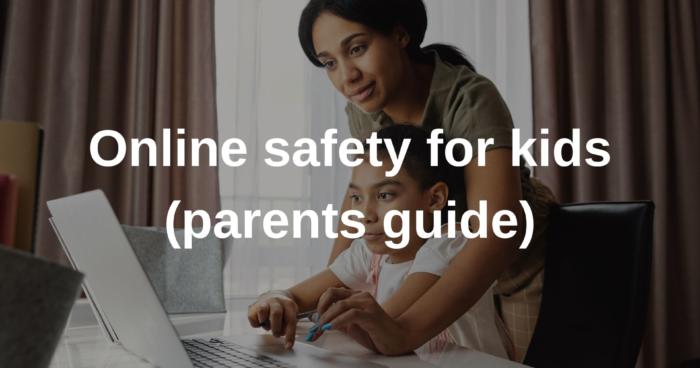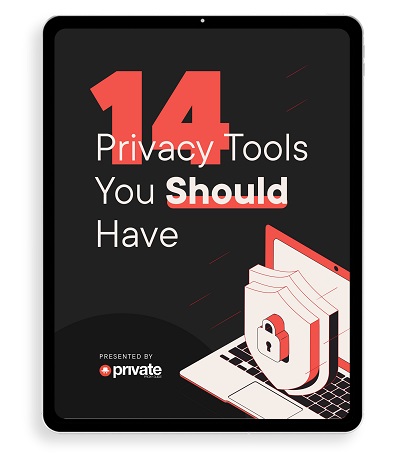Today’s children are deeply immersed in the digital world, engaging in social media, gaming, and online video consumption. While this connectivity offers opportunities for self-expression, it also introduces potential risks.
To ensure your child’s online safety, it’s essential to establish a secure digital environment. This involves setting boundaries on internet access, monitoring online activities, and educating them about online safety, especially regarding potential threats.
The good news is that implementing technical safeguards is straightforward. However, the most effective approach is open communication with your children. This parent’s guide aims to assist you in creating a safe online space for your kids.
1. What are the different types of online safety threats?
Common online safety threats encompass cyberbullying, sexting, and online scams.
-
Cyberbullying: This occurs when someone harasses or threatens another person through digital means.
-
Sexting: Involves the unsolicited sharing of explicit images or videos.
-
Online Scams: These scams trick individuals into surrendering money, often by impersonating legitimate entities. Be cautious of unfamiliar or suspicious requests, such as extreme demands for personal information or unexpected money requests.
If you encounter cyberbullying, sexting, or scams, promptly contact your school or local authorities for assistance and protective measures.
While these are some common online safety threats, stay vigilant and alert to your digital surroundings, as other risks may also emerge.
2. How do you teach your child about online safety?
Teaching your child online safety involves several steps:
-
Open Communication: Begin by discussing their online activities and interests. Encourage open dialogue about their online experiences.
-
Parental Controls and Monitoring: For older children, consider setting up parental control accounts and monitoring their online actions to ensure safe browsing.
-
Secure Settings: Establish family-safe browser settings and emphasize the importance of using strong, unique passwords for accounts and devices.
-
Online Awareness: Foster a sense of online awareness. Teach them never to share personal information, refrain from disclosing personal details about themselves or others, and avoid posting identifiable content.
By following these steps, you can help your child navigate the internet safely and responsibly.
Use “family safe browser.”
A family-safe browser is a browser that is designed to keep your family safe online. It will block harmful websites, track how often your children visit them and provide other safety features.
Let us further look in detail at the various options and solutions available to discuss online safety measures for kids.
3. Online Safety For Kids-Parental Guide
3.1 Mobile Phones and Applications

Mobile phones are popular among children but require safety measures:
-
Choose the Right Phone: Select a phone suitable for your child’s age and needs, considering customization options.
-
App and Game Research: Investigate apps and games available for the chosen phone. Some can be harmful or addictive. Set time limits for usage.
-
Security Measures: Protect phones from hacking or theft by never sharing personal information, using passcodes, installing updates, and employing unique passwords for websites and apps.
-
Teach Online Safety: Educate children about the importance of not sharing personal details online.
-
Communication: Talk to your child about their online activities and seek advice from parent support groups or child protective services if concerned.
By following these steps, you can ensure your child’s safe and responsible use of mobile phones.
3.2 Controls for the operating system which are built-in.

Windows offers built-in safety controls for online security:
-
Windows Defender: Protects against viruses and malware. Access it in the Control Panel under Security.
-
Windows Hello: Enables secure sign-in via face or fingerprint. Found in the Settings app (Windows 8) or System Tray (Windows 10).
-
Windows Security Center: Keeps track of security updates and antivirus status.
-
Windows Update: Keeps your system current with security updates, located in the Control Panel under System and Security.
-
Windows Defender Advanced Threat Protection: Blocks malicious threats. Available via Microsoft subscription.
-
Child Safety Online Protection: Guards kids from online risks like inappropriate content and cyberbullying. Available via Microsoft subscription.
-
Windows Live Family Safety: Manages passwords, blocks dangerous websites, and monitors home network activity. Obtainable through a Microsoft subscription.
-
Windows Update History: Displays installed updates and installation dates. Located in the Control Panel under System and Security.
Utilize these built-in Windows features to enhance online safety for your family.
iOS Online Safety Features For Kids
iOS offers robust online safety features for children:
-
Parental Controls: Parents can manage online content, websites, and time spent. Set website time limits, block categories (e.g., social media), and require passwords.
-
Content Filters: Protect kids from inappropriate content like adult websites, violence, or gambling sites by applying filters.
-
Monitoring: Monitor your child’s online activity through iOS parental controls, taking action if needed, such as deleting inappropriate posts or enforcing device downtime.
-
Password Security: Ensure your child’s online accounts are secure by teaching them strong password creation following easy-to-remember guidelines.
With these iOS features, parents can safeguard their children’s online experiences effectively.
3.3 Smart TVs and streaming content

Today’s children are deeply engaged with their devices, whether it’s streaming music, watching YouTube, or gaming on smartphones and tablets. However, ensuring their safety in the digital realm is essential, including on smart TVs and streaming platforms.
Online safety considerations for kids:
-
Awareness of Potential Risks: No device is entirely risk-free. Instances of device-related injuries and online predator encounters emphasize the need for vigilance. Parents should monitor their child’s online interactions, shared information, and in-person meetings.
-
Parental Controls: Establishing parental control accounts on their devices is an effective way to enhance online safety. This allows you to limit website access, disable specific features, and block certain applications. Tailor these restrictions for various devices like smartphones and tablets.
-
Content Monitoring: It’s vital to monitor the content your child consumes, as TV shows and movies may not always be age-appropriate. Employ filters on your home network to prevent access to inappropriate content.
-
Streaming Content Awareness: Familiarize yourself with the streaming content available to your children. Many streaming platforms offer parental controls to restrict access to certain content. Check content ratings before downloading or watching to ensure suitability.
By implementing these measures, you can create a safer online environment for your children across various devices and digital activities.
3.4 Online games and gaming consoles

Online gaming offers more than just entertainment for kids, but safety is crucial. Here are tips to ensure their well-being:
-
Guidelines for Gameplay: Teach your kids not to share game progress or personal information like passwords.
-
Parental Controls: Set up controls on devices and consoles to monitor and restrict activities, including time limits and website access.
-
Cyber-Bullying Education: Discuss cyber-bullying’s harm and let your kids know they can report any negative online experiences to you or a trusted adult.
-
Regular Monitoring: Check their online activity regularly, watching for signs of inappropriate behavior. Take action if you notice anything concerning.
-
Gaming Policy: Establish a clear gaming policy outlining allowed activities and responsible online behavior to promote safety and etiquette.
-
Safe Downloads: Educate your kids about the risks of downloading games from unreliable websites, emphasizing the importance of official sources to avoid malware or unwanted software.
By following these steps, you can ensure your child’s safety while gaming online.
3.5 Social Media

Online dangers pose a significant risk to children, especially on social media platforms like Facebook, Twitter, and Instagram. To safeguard your children online, follow these steps:
-
Set Clear Rules: Establish ground rules for social media use, specifying allowed content like family photos and emphasizing proper spelling and grammar.
-
Regular Monitoring: Keep an eye on your children’s social media activity, checking for inappropriate posts or actions, and engage in conversations about their online behavior.
-
Remove Harmful Content: If you find hurtful or derogatory posts, have them delete the content and discourage such behavior in the future.
-
Teach Values: Instill values like respect and healthy online habits before your children start using social media, encouraging them to follow your guidelines.
-
Online Safety Talks: Have conversations about online safety and assure your children that they can always discuss concerns with you. Consider implementing parental controls for added protection.
If your child experiences negative online effects, seek help promptly, as resources are available for those impacted by online abuse or cyberbullying.
3.6 Cyberbullying

Cyberbullying is a growing concern affecting both kids and adults, with a 200% increase in recent years, according to the Cyberbullying Research Center. It takes various forms, such as hurtful tweets and online rumors, causing fear and distress, especially among children.
To address cyberbullying:
-
Talk to Your Kids: Discuss the importance of treating others kindly online and never sending hurtful messages.
-
Secure Internet Connection: Ensure your kids have access to a safe internet environment, both online and offline.
-
Set Internet Rules: Establish guidelines like not sharing personal information without permission and teach them how to report cyberbullying incidents.
Be vigilant for warning signs:
- Changes in behavior, mood, or sleep.
- Increased isolation and disinterest in usual activities.
- Academic decline and anger outbursts.
- Sudden avoidance of school or social events.
- Unusual physical or emotional symptoms.
- A desire to abruptly switch off devices.
- Nervousness when receiving messages.
Staying aware of your child’s behavior is key to preventing or addressing cyberbullying effectively.
Stopbullying.gov has further information on how to stop bullying. You can also find help for your child on https://kidshealth.org/en/parents/cyberbullying.html in such cases.
3.7 Privacy and information security

Parents must prioritize their child’s online privacy and safety. Here are the crucial steps:
-
Antivirus Protection: Ensure your computer has updated antivirus software to safeguard against viruses and malware.
-
Password Protection: Safeguard your child’s passwords, never sharing them and ensuring they don’t leave their computer unattended.
-
Educate About Clicking Links: Teach your child about the risks of clicking unknown links and sharing personal information without verifying a website’s legitimacy.
-
Taking Action: If you suspect online predators targeting your child, contact local law enforcement or the National Center for Missing and Exploited Children (NCMEC) promptly. NCMEC provides a hotline for reporting online child exploitation (1-800-THE-LOST).
3.8 Online viewing of objectionable material

Parents should actively monitor their children’s online activities. Today, access to harmful content is easier and more prevalent among kids than ever before. A Pew Research Center study found that 73% of Internet users under 18 have encountered inappropriate online material.
To protect your child online:
-
Establish Clear Boundaries: Set guidelines for online content, including website access and regularly check the sites they visit.
-
Teach Online Safety: Educate your child on using available online tools and filters to enhance safety, as tech-savvy kids may attempt to bypass parental controls.
Contact a trusted adult immediately if you see anything that makes you concerned about your child’s online safety. Several resources help parents keep their children safe online, such as the National Cybersecurity Alliance’s SaferNetInfo.org etc.
3.9 Predators online

In our final section, we address a grave concern: internet child predators. Alarming statistics show that one in 25 children has been approached for offline contact, and 50% of online sexual exploitation victims are aged 12 to 15, according to the US Department of Justice. Thirteen percent of children with internet access have experienced unwelcome sexual approaches.
For a secure online environment, consider these steps:
-
Strong Passwords: Create unique and strong passwords, avoiding reuse across multiple sites. Utilize a password generator for added security.
-
Stay Informed: Keep abreast of online security threats by regularly reviewing browser privacy settings, updating antivirus software, and maintaining current browser plugins.
-
Social Media Caution: Kids are vulnerable to cyberbullying on social media. Ensure responsible usage and discuss potential risks before granting access to these platforms.
-
Digital Etiquette: Teach children the importance of online politeness and proper interactions. Emphasize not sharing personal information and being mindful of what they post.
-
Set Technology Boundaries: Establish guidelines for technology usage, specifying when and how much screen time is allowed to prevent excessive screen reliance.
-
Online Identity Protection: Assist children in creating and securing online accounts, setting up parental controls on devices, and avoiding personal information disclosure during sign-ups.
-
Online Safety Talks: Have open discussions about online safety, explaining the risks of internet predators and promoting safe technology use.
By implementing these measures, you can prioritize your child’s online safety.
Helpful resources: Check out the sites below to learn more about Internet safety for kids.
- OnGuardOnline: The Federal Trade Commission produced this site, including information for parents and games and films for children and teenagers.
- The National Center for Missing & Exploited Children’s website includes videos for children of all ages and videos and advice for parents.
- WiredSafety: WiredSafety provides parents and educators with a wealth of information about internet safety.
- The Family Online Safety Institute includes a downloadable Family Online Safety Contract and other tools and suggestions for parents on their website.
- A Platform for Good, has information for teachers, parents, and teens.
- Microsoft Online Safety Information: The page provides Internet safety tips for individuals, families, schools, and businesses.
Cyberbullying
- Cyberbullying.org: This site, created by WiredSafety.org, provides information for children aged 7 to 17. This website has materials for children and teenagers and ways to discuss cyberbullying with parents.
- Common Sense Media: The website provides specific guidelines for dealing with children aged 2 to 17.
- Project It Gets Better: This website was formed due to teen suicides caused by bullying because they were LGBT. It has over 22,000 videos, many of which were provided by celebrities.
Children’s and adolescent’s websites
- The National Center for Missing and Exploited Children produced this site, which offers films tailored for various age groups. NetSmartzKids and NSTeens are both related to it.
- NetSmartzKids is a website with Internet security games for kids aged 5 to 10.
- NSTeens: This NetSmartz website is for tweens and adolescents aged eight to seventeen.
If your kid is in danger, who should you call?
Police in the area: You should dial 911 if your kid is in urgent danger. Otherwise, you can report an issue to your local police department’s non-emergency hotline.
CyberTipline: To report offenses against children, go to www.cybertipline.com/call (800) 843-5678, which includes internet seduction of minors for sexual actions, obscene material delivered to a kid, and pornography.
4. Final takeaways
Online safety is paramount to teaching your children. Please read through our guide, and here are a few easy tips to keep them safe online:
- Make sure your kids have a cyber security plan in place. It should include passwords for all devices, create a unique email address for each account, and ask them not to share personal information online.
- Set rules about what your children can and can’t do online. For example, they shouldn’t be allowed to access social media when they’re not at home and use their phones or computers while they’re at school.
- Make sure your kids know how to report any incidents or problems they may experience online. They can call family members or go to www.webhelp.org for advice.
- Encourage your kids to use online safety tools like mSafe. This app allows kids to monitor their online activity and see which websites have often visited.
- Discuss with them the dangers of online predators. Explain that there are people out there who will try to use your children to access their personal information or money.
- Help keep kids safe online by setting up parental control software like Net Nanny, Cyber Patrol, or Websense Parental Controls.
- Make sure your kids know that they can always call you or the police if they experience any problems online.
- Keep the computer updated with the latest antivirus software.
- Talk to your kids about reporting any suspicious activity or online threats to their parents or school officials.
- Make sure your kids know that they can always get help from a trusted adult if they need it.
- Be connected to the Internet to help if needed.
- Ensure that your kids are using caution when they’re online and avoid using any words or phrases that could be offensive or harmful.
- Keep your kids active and involved in activities outside of the computer. It will help them develop other social skills and interests, which will help them be safer online.
- Please don’t give your kids your passwords or let them use your computer without your supervision. You can use a password manager to store and create strong passwords.
- Be supportive and understanding when your kids make mistakes online, and remind them that you love them no matter what.
- Teach your kids the importance of taking precautions online and using common sense.
5. Conclusion
We earn commissions using affiliate links.


![Essential Tips for Internet Safety for Seniors [year] Internet Safety for Seniors](https://www.privateproxyguide.com/wp-content/uploads/2022/06/Internet-Safety-for-Seniors-150x150.jpg)
![7 Best VPN for Match.com [year]: Secure & Private Online Dating BEST VPN for Match.com](https://www.privateproxyguide.com/wp-content/uploads/2020/09/best-vpn-for-match.com_-150x150.jpg)
![7 Best VPN for GTA 5 Online [year]: Fast Servers for Gaming Best VPN for GTA Online](https://www.privateproxyguide.com/wp-content/uploads/2022/01/Best-VPN-for-GTA-Online-150x150.jpg)
![Best Zoom Alternatives [year] Top Picks for Online Meetings Best Zoom Alternatives](https://www.privateproxyguide.com/wp-content/uploads/2022/01/Best-Zoom-Alternatives-150x150.jpg)
![Best Web Hosting for Small Businesses to Grow Online [year] Best web hosting for small business](https://www.privateproxyguide.com/wp-content/uploads/2022/03/Best-web-hosting-for-small-business-150x150.jpg)
![How to Watch Premier League Online in [month] [year] How to watch premier league online](https://www.privateproxyguide.com/wp-content/uploads/2022/03/How-to-watch-premier-league-online-1-150x150.jpg)
![Best VPN for PokerStars [year]: Secure & Fast Online Poker Best VPN for PokerStars](https://www.privateproxyguide.com/wp-content/uploads/2022/05/Best-VPN-for-PokerStars-150x150.jpg)
![How to Watch Formula 1 Online in in [month] [year] How to watch Formula 1 Online](https://www.privateproxyguide.com/wp-content/uploads/2022/05/How-to-watch-Formula-1-Online-1-150x150.jpg)
![Best Free Online Virus Scanners [year] Quick & Effective Best Online Virus Scanners](https://www.privateproxyguide.com/wp-content/uploads/2022/06/Best-Online-Virus-Scanners-150x150.jpg)
![10 Best VPN for Banking [year]: Secure & Private Online Banking Best VPN for Banking](https://www.privateproxyguide.com/wp-content/uploads/2022/08/Best-VPN-for-Banking-150x150.jpg)
![10 Best VPN for Black Desert Online [year]: Fast Servers for Gaming Best VPN for Black Desert Online](https://www.privateproxyguide.com/wp-content/uploads/2023/10/Best-VPN-for-Black-Desert-Online-150x150.jpg)



![How to Update Kodi: Step-by-Step Guide for [year] How to Update Kodi for Different Platforms in 2021](https://www.privateproxyguide.com/wp-content/uploads/2018/09/how-to-update-kodi-150x150.jpg)